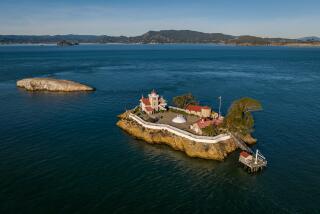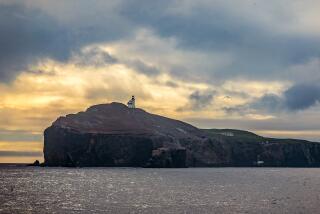Where Old Money Played
- Share via
JEKYLL ISLAND, Ga. — From the white, turreted tower of the late 19th century Jekyll Island Club, a middle-age man in polo shirt and baggy shorts leaned over the terrace rail and surveyed his storied surroundings, a casual king looking over his domain.
In front of him was the wharf where J.P. Morgan’s tremendous yacht used to arrive from across the grassy, yellow-green inland marshes that stretch to the mainland Georgia coast. To his right and left were the preserved, mansion-like cottages of millionaires who bought the island to create their own winter playground, south of everything but undeveloped Florida, in 1886.
And all around were the serene, ancient stands of Georgia live oaks draped with Spanish moss, shading the bike trails and pathways that circle and crisscross the island.
Jealously looking up from the ground just below, I hoped to share the view. “How do you get up there?” I called out.
The answer that floated down was simpler than I expected: “Rent the room.”
The once-exclusive coastal Sea Islands of southeast Georgia, the turn-of-the-century private preserves of the Carnegies, Astors, Rockefellers and other Northeast barons of industry and finance, are now the province of tourists and day-trippers who can surround themselves with history, luxury and natural beauty, all in one place.
The string of unsung barrier-beach islands stretches south for 100 miles from Savannah, Ga., almost to Jacksonville, Fla. Most of the islands are nearly untouched, and many are reachable only by boat. They include the nearly untamed wildlife refuges of Sapelo and Cumberland and the antique shops and near-suburban streets of St. Simons; the $500-and-up beachfront rooms of the Cloister at Sea Island and the Jekyll Island Club, where rooms overlooking the Intracoastal Waterway begin at $119 and the two-story Presidential Suite turret goes for $259 a night.
*
Together, they are now known as Georgia’s Golden Isles, although the name centers on the cluster accessible by car--Jekyll, St. Simons and Sea Island--where my travel mate and I spent five unusually warm April days. Though the Atlantic waters were still cold, we sunbathed on the hard-packed sand, swam in heated pools, kayaked through marsh mazes, bicycled miles of scenic trails and strolled the pathways of a lost era of opulence.
And--perhaps this is the unusual part--we boarded a motorized open-air tram for a rolling tour of the history around our hotel.
The Jekyll Island Club is a singular story in itself. At a time when a fast-moving economy was making sudden millionaires right and left, a small group of industrialists in fields from railroads to plumbing reputedly sent a team to find a place with warm winters they could call their own, a place that was both unspoiled and easy to get to from New York. Once they settled on Jekyll Island, a declining cotton plantation that they bought for $125,000, they built the clubhouse that is now the hotel and outfitted it with a chef and staff from Delmonico, the famous Manhattan steakhouse. They built an infirmary, staffed by doctors from Johns Hopkins; they had a gamekeeper stock the grounds with quail and pheasant and outfitted a taxidermy shop to mount the spoils of their hunting excursions.
In the next couple of decades, some club members decided to build their own cottages ringing the clubhouse, and many of them still stand. George Macy, president of Union Pacific Tea (later A&P;), had one with 13 bedrooms; William Rockefeller of Standard Oil had one with an elevator and a large cedar-lined safe. Joseph Pulitzer, the publisher who endowed the Pulitzer Prizes, had his cottage soundproofed. Some of the homes were built without kitchens; the members, after all, didn’t plan to miss the Delmonico meals at the clubhouse.
*
By the end of World War II, however, the club’s time had passed. In 1947, the state bought the island for $675,000, making a state park and marking the area around the clubhouse and cottages as a historical district. Also still standing are a tiny church that holds one of five surviving stained-glass windows signed by Louis Comfort Tiffany, a suite of apartments billed as the nation’s first condominium and the infirmary (now a rambling bookstore).
Three of the cottages can be toured by a tram that departs from the Jekyll Island Museum in the old stables; another has been made into an art gallery; outbuildings have been turned into shops, and one cottage is due to become a bed and breakfast. And then there’s the restored Jekyll Island Club, now managed by the Radisson chain, with almost all of its architecture and much of its style intact.
The rooms themselves are unspectacular--and at the bottom of the price range, they’re tiny, so it’s important to get one with a view over the water or across the croquet lawn, rather than the back of the building. But the wide, interconnected terraces dotted with wicker rockers and the sedate public rooms retain their grace.
We spent most of a day on Jekyll just exploring by bicycle. We passed modest homes and beach-side condominiums and stretches of nothing but the embracing branches of the live oaks in one wild formation after another. After about four miles, we rounded the island’s northernmost point, from which we could see the lighthouse of St. Simons Island, and then came upon the broad, flat, hard-packed beach.
It wasn’t the kind of pillowy sand ideal for lounging; in fact, we could ride our bikes on it as easily as on a road. The shallow ocean water, in addition to still being cold below the surface, was dark and murky with sediment that washes in from the marsh side--perfectly harmless, but uninviting. But the beach was alive with people building sandcastles and gathering shells.
A curious sandbar formation attracted us and dozens of other beach-goers; it jutted out perpendicularly to the beach and into the water like a natural pier for perhaps a quarter-mile, pockmarked all the way with little pools of water that caught the light of the afternoon sun.
*
On St. Simons and Sea Island, a 1928 Spanish Mediterranean-style resort has grown into a gold-plated 264-room complex of hotel and condominium buildings, and the luxuries of the past on view on Jekyll Island were translated to those of the present.
Two pools, a broad lawn of lounge chairs and an outdoor restaurant front the beach at the Cloister resort. A packed brochure of available activities included spa treatments, tennis clinics, boat trips and nature walks, as well as a pair of gorgeous golf courses.
The Cloister occupies the south end of Sea Island, but its influence extends throughout the two islands. All of Sea Island was developed by the resort company as a huge colony of palatial cottages, and a bicycle ride up and down the length, five miles each way, proved to be a tour of extravagant houses set among the area’s trademark live oaks.
On St. Simons, we finally used our car to tour around, although pleasant bike paths parallel the streets there as well. We found a quaint village by the lighthouse, antique shops full of bargains, and the toy wooden Christ Church with its ancient cemetery.
Before we left Georgia, I visited Tybee Island, the northernmost of the islands and closest to Savannah, and found it had nothing in common with those to the south. Other than a historical lighthouse, Georgia’s tallest and oldest, it was a mundane collection of economy hotels and parking lots. Georgia’s gold lay elsewhere.
(BEGIN TEXT OF INFOBOX / INFOGRAPHIC)
GUIDEBOOK
Golden Isles Getaway
Getting there: From Los Angeles, the nearest airports to the Golden Isles are in Brunswick, Georgia (14 miles from Jekyll Island) and Jacksonville, Florida (42 miles). Jacksonville is served on connecting flights by most major airlines; lowest advance-purchase restricted fare is $352. Brunswick is served by Delta via Atlanta (the last leg is on a small commuter plane); lowest restricted fare is $400. Jekyll and Sea islands are just under an hour’s drive north from the Jacksonville airport, and about 20 minutes longer going south from Savannah.
Getting around, island by island:
Jekyll Island is reached from Interstate 95 by the Jekyll Island Causeway. The Jekyll Island Club, run by Radisson, has room rates of $119 to $259 in spring and summer; $169 gets a deluxe king room with a porch. Packages including golf, meals and tennis are available; telephone (800) 535-9547 or (912) 635-2600, fax (912) 635-2818.
St. Simons and Sea Island are reached by bridge from Brunswick. The Cloister at Sea Island charges $335 a night for basic rooms, $540 and up for oceanfront rooms. The price includes meals, served in four different restaurants, but virtually none of the available activities; tel. (800) 732-4752 or (912) 638-3611, fax (912) 638-5823.
Little St. Simons Island, still privately owned, can be visited by only 24 overnight guests at a time. It is empty except for the wildlife and the tiny Lodge at Little St. Simons. Rates to stay in a 1917 hunting lodge, a 1930s bungalow or modern cottages are $360 to $500 October to May, and $275 to $375 in the summer, including meals and drinks. The entire island can be rented to a group for $3,150 to $4,400 per night; tel. (888) SEE-LSSI, (912) 638-7472, fax (912) 634-1811. Day trips to the island by charter boats can also be arranged through The Cloister or the Brunswick Visitor’s Bureau, tel. (912) 265-0620.
Sapelo Island is a National Estuarine Sanctuary; a marine institute has been established in the cow barn of a 1930s South End mansion, and $10 half-day tram tours connected with the institute are available Wednesdays and Saturdays (and Fridays in summer) by advance reservation. Ferries leave from Darien; tel. (912) 437-3224.
Cumberland Island can be reached year-round by the national parks service ferry from St. Mary’s. The schedule varies by season, and weekend seats must be booked well in advance; tel. (912) 882-4335 weekdays for ferry or camping reservations. A National Seashore nature preserve larger than Manhattan, the island has 50-foot dunes, wild horses roaming the beach and sea turtles laying eggs in the summer. You can stay at the Greyfield Inn, an antique-furnished lodge built by the Carnegies; tel. (904) 261-6408, fax (904) 321-0666. Rates of $275 to $395 include meals; the hotel’s own ferry leaves from Fernandina Beach, Fla.
For more information: Georgia Department of Industry, Trade and Tourism, P.O. Box 1776, Atlanta, GA 30301-1776; tel. (800) 847-4842 or (404) 656-3590, fax (404) 651-9063.
More to Read
Sign up for The Wild
We’ll help you find the best places to hike, bike and run, as well as the perfect silent spots for meditation and yoga.
You may occasionally receive promotional content from the Los Angeles Times.






